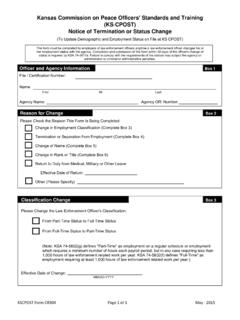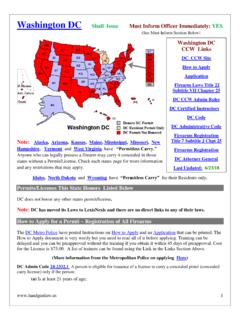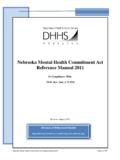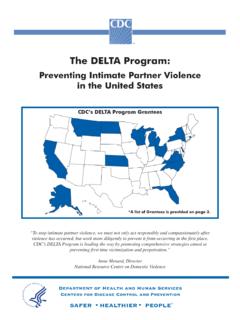Transcription of Kansas Emergency Medical Services Education …
1 Kansas Emergency Medical Services Education standards paramedic Page 1 of 374 KSBEMS paramedic JULY, 2010. Contents Preparatory EMS Systems (PR1) Page 5. Preparatory Research (PR2) Page 13. Preparatory Workforce Safety and Wellness (PR3) Page 16. Preparatory Documentation (PR4) Page 20. Preparatory EMS System Communication (PR5) Page 22. Preparatory Therapeutic Communication (PR6) Page 24. Preparatory Medical /Legal Ethics (PR7) Page 29. Preparatory Anatomy and Physiology (PR8) Page 35. Preparatory Medical Terminology (PR9) Page 59. Preparatory Pathophysiology (PR10) Page 60.
2 Preparatory Life Span Development (PR11) Page 76. Preparatory Public Health (PR12) Page 80. Pharmacology Principles of Pharmacology (PR13) Page 82. Pharmacology Medication Administration (PR14) Page 89. Pharmacology Emergency Medications (PR15) Page 91. Airway Mgmt Restoration and Artificial Vent Airway Management (AM1) Page 93. Airway Mgmt Restoration and Artificial Vent Respiration (AM2) Page 97. Airway Mgmt Restoration and Artificial Vent Artificial Ventilation (AM3) Page 103. Patient Assessment Scene Size-Up (PA1) Page 105. Patient Assessment Primary Assessment (PA2) Page 108.
3 Patient Assessment History-Taking (PA3) Page 110. Patient Assessment Secondary Assessment (PA4) Page 120. Patient Assessment Monitoring Devices (PA5) Page 132. Page 2 of 374 KSBEMS paramedic JULY, 2010. Patient Assessment Reassessment (PA6) Page 134. Medicine Medical Overview (MT1) Page 135. Medicine Neurology (MT2) Page 139. Medicine Abdominal and Gastrointestinal Disorders (MT3) Page 143. Medicine Immunology (MT4) Page 148. Medicine Infectious Disease (MT5) Page 151. Medicine Endocrine Disorders (MT6) Page 162. Medicine Psychiatric (MT7) Page 164. Medicine Cardiovascular (MT8) Page 167.
4 Medicine Toxicology (MT9) Page 199. Medicine Respiratory (MT10) Page 206. Medicine Hematology (MT11) Page 212. Medicine Genitourinary/Renal (MT12) Page 215. Medicine Gynecology (MT13) Page 220. Medicine Non-Traumatic Musculoskeletal Disorders (MT14) Page 223. Medicine Diseases of the Eyes, Ears, Nose, and Throat (MT15) Page 225. Shock and Resuscitation (ST1) Page 228. Trauma Trauma Overview (ST2) Page 239. Trauma Bleeding (ST3) Page 243. Trauma Chest Trauma (ST4) Page 250. Trauma Abdominal and Genitourinary Trauma (ST5) Page 257. Trauma Orthopedic Trauma (ST6) Page 262.
5 Trauma Soft Tissue Trauma (ST7) Page 267. Trauma Head, Facial, Neck, and Spine Trauma (ST8) Page 273. Page 3 of 374 KSBEMS paramedic JULY, 2010. Trauma Nervous System Trauma (ST10) Page 278. Trauma Special Considerations in Trauma (ST11) Page 283. Trauma Environmental Emergencies (ST12) Page 288. Trauma Multi-System Trauma (ST13) Page 294. Special Patient Populations Obstetrics (SP1) Page 298. Special Patient Populations Neonatal Care (SP2) Page 304. Special Patient Populations Pediatrics (SP3) Page 321. Special Patient Populations Geriatrics (SP4) Page 336. Special Patient Populations Patients with Special Challenges (SP5) Page 351.
6 EMS Ops Principles of Safely Operating a Ground Ambulance (OP1) Page 365. EMS Operations Incident Management (OP2) Page 366. EMS Operations Multiple Casualty Incidents (OP3) Page 367. EMS Operations Air Medical (OP4) Page 368. EMS Operations Vehicle Extrication (OP5) Page 369. EMS Operations Hazardous Materials Awareness (OP6) Page 372. EMS Ops Mass Cal Incidents Due to Terrorism and Disaster (OP7) Page 373. Contents and abbreviations developed by Hutchinson Community College staff. Page 4 of 374 KSBEMS paramedic JULY, 2010. Preparatory EMS Systems PR1. paramedic Education Standard Integrates comprehensive knowledge of EMS systems, safety/well being of the paramedic , Medical /legal and ethical issues, which is intended to improve the health of EMS personnel, patients, and the community.
7 paramedic -Level Instructional Guideline The paramedic Instructional Guidelines in this section include all the topics and material at the EMR, EMT and AEMT level PLUS the following material: I. History of EMS. A. EMS Prior to World War I. 1. 1485 Siege of Malaga, first recorded use of ambulance by military, no Medical care provided 2. 1800s Napoleon designated vehicle and attendant to head to battle field a. 1860 first recorded use of medic and ambulance use in the United States b. 1865 first civilian ambulance, Commercial Hospital of Cincinnati, Ohio c. 1869 First ambulance service, Bellevue Hospital in New York, NY.
8 D. 1899 Michael Reese Hospital in Chicago operates automobile ambulance B. EMS Between World War I and II. 1. 1900s Hospitals place interns on ambulances, first real attempt at scene and transport care 2. 1926 Phoenix Fire Department enters EMS. 3. 1928 First rescue squad launched in Roanoke, VA. Squad implemented by Julien Stanley Wise and named Roanoke Life Saving Crew 4. 1940s a. Many hospital-based ambulance Services shut down due to lack of manpower resulting from WWI. b. City governments turn service over to police and fire departments c. No laws on minimum training d.
9 Ambulance attendance became a form of punishment in many fire depts. C. Post-World War II. 1. 1950s a. 1951 Helicopters used during Korean War b. 1956 Mouth-to-mouth resuscitation developed by Dr. Elan and Dr. Safar c. 1959 First portable defibrillator developed at Johns Hopkins Hospital 2. 1960s a. 1960 LAFD puts Medical personnel on every engine, ladder, and rescue company b. 1965 Accidental Death & Disability: The Neglected Disease of Modern Society or The White Paper i. Lack of uniform laws and standards ii. Ambulances and equipment of poor quality iii. Communication lacking between EMS and hospital iv.
10 Training of personnel lacking v. Hospitals used part time staff in ED. vi. More people died in auto accidents than in Vietnam War c. 1966. i. EMS Guidelines Highway Safety Act, Standard 11. Page 5 of 374 KSBEMS paramedic JULY, 2010. ii. Delivery of pre-hospital care using ambulances by Dr. Frank Pantridge in Belfast, Ireland d. 1967 -- AAOS creates Emergency Care and Transportation of the Sick and Injured.. First textbook for EMS personnel e. 1968. i. Task Force of the Committee of EMS drafts basic training standards , results in Training of Ambulance Personnel and Others Responsible for Emergency Care of the Sick and Injured at the Scene and During Transport by Dunlop and Assoc.






